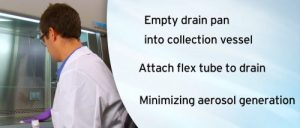How To Clean Biosafety Cabinet
Decontamination of your Nuaire Biological Safety Cabinet (BSC) is important for many reasons, such as keeping you and your laboratory safe from harmful toxins and spills while working in the BSC, and also for the validity and quality of your experiments. In this article, NuAire has outlined 10 of the most important BioSafety Cabinet Decontamination steps which should be performed after every use:
- Enclose any items which have been in contact with the agent and cover any waste containers.
- Allow the cabinet to operate for 5 minutes with no activity, which should purge airborne contaminants from the work area.
- Clean/decontaminate all containers and equipment and then remove from the cabinet

- Once the cabinet is empty, you should allow 20-30 minutes to thoroughly decontaminate all interior work surfaces, making sure to clean the back and side of the cabinet, and the interior of the glass. This may take more or less time depending on the disinfectant and the microbiological agent used.
- If using a chloride type disinfectant, after contact time, wipe down interior surfaces with a 70% alcohol solution to protect stainless steel interiors from corrosion.
- The drain pan should be emptied into a collection
 vessel containing disinfectant; and the drain valve can be disinfected using a flexible tube (see video below)
vessel containing disinfectant; and the drain valve can be disinfected using a flexible tube (see video below) - Any spilled fluid and disinfectant solution on the work surface should be absorbed with paper towels and discarded into a biohazard bag.
- Hands should be washed whenever gloves are changed or removed.
- If necessary, the cabinet should also be monitored for radioactivity and decontaminated when necessary.
- The cabinet can be turned off and the vertically sliding window closed. If desired, the Ultra Violet (UV) light may be turned on. The Centers for Disease Control (CDC), National Institute of Health (NIH), and National Science Foundation (NSF) all agree that UV lamps are neither recommended, nor required in Biological Safety Cabinets; however, if you are going to use one please follow the safety guides below to ensure you and your lab's safety:
-
- The room should never be occupied when UV lamp is in use (UV light will damage the human eye and skin very quickly).
- Vertical sliding window must be closed. If it has a hinged window, use manufactures enclosure panel.
- Lamp must be wiped free of dust/linT weekly.
- UV wavelength must be checked periodically.
- Thoroughly wash your hands and arms with warm, soapy water. Personnel should remove their gloves and gowns and wash their hands as the final step in safe microbiological practices
The use of a UV light should never be a substitute for good decontamination practices. If absolutely necessary it should be used in addition to the above decontamination steps. To read Nuaire's full safety guide, click here.
How To Clean Biosafety Cabinet
Source: https://www.labrepco.com/2018/01/31/biological-safety-cabinets-10-step-decontamination-guide/
Posted by: saxontiontems.blogspot.com

0 Response to "How To Clean Biosafety Cabinet"
Post a Comment